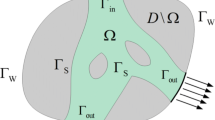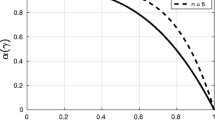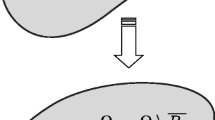Abstract
This paper deals with a multi-objective topology optimization problem in an asymmetrically heated channel, based on both pressure drop minimization and heat transfer maximization. The problem is modeled by assuming steady-state laminar natural convection flow. The incompressible Navier-Stokes equations coupled with the convection-diffusion equation, under the Boussinesq approximation, are employed and are solved with the finite volume method. In this paper, we discuss some limits of classical pressure drop cost function for buoyancy-driven flow and, we then propose two new expressions of objective functions: the first one takes into account work of pressure forces and contributes to the loss of mechanical power while the second one is related to thermal power and is linked to the maximization of heat exchanges. We use the adjoint method to compute the gradient of the cost functions. The topology optimization problem is first solved for a Richardson (Ri) number and Reynolds number (Re) set respectively to Ri ∈{100,200,400} and Re = 400. All these configurations are investigated next in order to demonstrate the efficiency of the new expressions of cost functions. We compare two types of interpolation functions for both the design variable field and the effective diffusivity. Both interpolation techniques have pros and cons and give slightly the same results. We notice that we obtain less isolated solid elements with the sigmoid-type interpolation functions. Then, we choose to work with the sigmoid and solve the topology optimization problem in case of pure natural convection, by setting Rayleigh number to {3 × 103,4 × 104,5 × 105}. In all considered cases, our algorithm succeeds to enhance one of the phenomenon modeled by the proposed cost functions without deteriorating the other one. The optimized design obtained suppresses any reversal flow at the exit of the channel. We also show that the thermal exchanges are improved by computing the Nusselt numbers and bulk temperature. We conclude that the new expressions of objective functions are well suited to deal with natural convection optimization problem in a vertical channel.















Similar content being viewed by others
References
Alexandersen J, Andreasen CS, Aage N, Lazarov BS, Sigmund O (2013) Topology optimisation for coupled convection problems. In: 10th World Congress on Structural and Multidisciplinary Optimization, Orlando, pp 19–24
Alexandersen J, Aage N, Andreasen CS, Sigmund O (2014) Topology optimisation for natural convection problems. Int J Numer Methods Fluids 76(10):699–721
Alexandersen J, Sigmund O, Aage N (2015) Topology optimisation of passive coolers for light-emitting diode lamps. In: 11th World Congress on Structural and Multidisciplinary Optimization
Alexandersen J, Sigmund O, Aage N (2016) Large scale three-dimensional topology optimisation of heat sinks cooled by natural convection. Int J Heat Mass Transfer 100:876–891
Alexandersen J, Sigmund O, Meyer KE, Lazarov BS (2018) Design of passive coolers for light-emitting diode lamps using topology optimisation. Int J Heat Mass Transfer 122:138–149
Asmussen J, Alexandersen J, Sigmund O, Andreasen CS (2018) A “poor man’s” approach to topology optimization of natural convection problems. arXiv:180901900
Athan TW, Papalambros PY (1996) A note on weighted criteria methods for compromise solutions in multi-objective optimization
Aung W (1972) Fully developed laminar free convection between vertical plates heated asymmetrically. Int J Heat Mass Transfer 15(8):1577–1580
Aung W, Fletcher L, Sernas V (1972) Developing laminar free convection between vertical flat plates with asymmetric heating. Int J Heat Mass Transfer 15(11):2293–2308
Bar-Cohen A, Rohsenow W (1984) Thermally optimum spacing of vertical, natural convection cooled, parallel plates. Journal of heat transfer 106(1):116–123
Bastide A, Cocquet PH, Ramalingom D (2018) Penalization model for navier-stokes-darcy equation with application to porosity-oriented topology optimization. Mathematical Models and Methods in Applied Sciences, https://doi.org/10.1142/S0218202518500409
Bendsøe MP, Kikuchi N (1988) Generating optimal topologies in structural design using a homogenization method. Comput Methods Appl Mech Eng 71(2):197–224
Bodoia J, Osterle J (1962) The development of free convection between heated vertical plates. J Heat Transf 84(1):40–43
Borrvall T, Petersson J (2003) Topology optimization of fluids in stokes flow. Int J Numer Methods Fluids 41(1):77–107
Brangeon B, Joubert P, Bastide A (2015) Influence of the dynamic boundary conditions on natural convection in an asymmetrically heated channel. Int J Therm Sci 95:64–72
Bruns T (2005) A reevaluation of the simp method with filtering and an alternative formulation for solid–void topology optimization. Struct Multidiscip Optim 30(6):428–436
Bruns TE (2007) Topology optimization of convection-dominated, steady-state heat transfer problems. Int J Heat Mass Transfer 50(15-16):2859–2873
Coffin P, Maute K (2016) Level set topology optimization of cooling and heating devices using a simplified convection model. Struct Multidiscip Optim 53(5):985–1003
Dbouk T (2017) A review about the engineering design of optimal heat transfer systems using topology optimization. Appl Therm Eng 112:841–854
Dede EM (2009) Multiphysics topology optimization of heat transfer and fluid flow systems. In: Proceedings of the COMSOL Users Conference
Desrayaud G, Lauriat G (2009) Flow reversal of laminar mixed convection in the entry region of symmetrically heated, vertical plate channels. Int J Therm Sci 48(11):2036–2045
Desrayaud G, Chénier E, Joulin A, Bastide A, Brangeon B, Caltagirone J, Cherif Y, Eymard R, Garnier C, Giroux-Julien S et al (2013) Benchmark solutions for natural convection flows in vertical channels submitted to different open boundary conditions. Int J Therm Sci 72:18–33
Elenbaas W (1942) Heat dissipation of parallel plates by free convection. Physica 9(1):1–28
Eschenauer HA, Olhoff N (2001) Topology optimization of continuum structures: a review. Appl Mech Rev 54(4):331–390
Everett H III (1963) Generalized Lagrange multiplier method for solving problems of optimum allocation of resources. Oper Res 11(3):399–417
Goeke S, Wünsch O (2017) Adjoint based topology optimization of conjugate heat transfer systems. PAMM 17(1):771–772
Guest JK, Prévost JH, Belytschko T (2004) Achieving minimum length scale in topology optimization using nodal design variables and projection functions. Int J Numer Methods Eng 61(2):238– 254
Haertel JH, Nellis GF (2017) A fully developed flow thermofluid model for topology optimization of 3d-printed air-cooled heat exchangers. Appl Therm Eng 119:10–24
Haertel JHK, Engelbrecht K, Lazarov BS, Sigmund O (2015) Topology optimization of thermal heat sinks. In: Proceedings of the 2015 COMSOL Conference, Grenoble
Hassani B, Hinton E (1998a) A review of homogenization and topology opimization ii—analytical and numerical solution of homogenization equations. Compos Struct 69(6):719–738
Hassani B, Hinton E (1998b) A review of homogenization and topology optimization i—homogenization theory for media with periodic structure. Compos Struct 69(6):707–717
Hassani B, Hinton E (1998c) A review of homogenization and topology optimization iii—topology optimization using optimality criteria. Compos Struct 69(6):739–756
Joo Y, Lee I, Kim SJ (2017) Topology optimization of heat sinks in natural convection considering the effect of shape-dependent heat transfer coefficient. Int J Heat Mass Transfer 109:123–133
Koga AA, Lopes ECC, Nova HFV, de Lima CR, Silva ECN (2013) Development of heat sink device by using topology optimization. Int J Heat Mass Transfer 64:759–772
Kontoleontos E, Papoutsis-Kiachagias E, Zymaris A, Papadimitriou D, Giannakoglou K (2013) Adjoint-based constrained topology optimization for viscous flows, including heat transfer. Eng Optim 45(8):941–961
Kreissl S, Maute K (2012) Levelset based fluid topology optimization using the extended finite element method. Struct Multidiscip Optim 46(3):311–326
Lazarov BS, Sigmund O (2011) Filters in topology optimization based on helmholtz-type differential equations. Int J Numer Methods Eng 86(6):765–781
Lee K (2012) Topology optimization of convective cooling system designs. PhD thesis, University of Michigan
Lei T, Alexandersen J, Lazarov BS, Wang F, Haertel JH, De Angelis S, Sanna S, Sigmund O, Engelbrecht K (2018) Investment casting and experimental testing of heat sinks designed by topology optimization. Int J Heat Mass Transfer 127:396–412
Li R, Bousetta M, Chénier E, Lauriat G (2013) Effect of surface radiation on natural convective flows and onset of flow reversal in asymmetrically heated vertical channels. Int J Therm Sci 65:9–27
Liang QQ (2007) Performance-based optimization: a review. Adv Struct Eng 10(6):739–753
Lim DK, Park Y, Kim H, et al. (2018) CFD-based shape optimization on cross-section of monoblock fusion divertor cooling channel for minimizing local heat flux. Fusion Eng Des 136:1100–1105
Lv Y, Liu S (2018) Topology optimization and heat dissipation performance analysis of a micro-channel heat sink. Meccanica 53(15):3693–3708
Marck G, Nemer M, Harion JL (2013) Topology optimization of heat and mass transfer problems: laminar flow. Numerical Heat Transfer Part B: Fundamentals 63(6):508–539
Messac A, Puemi-Sukam C, Melachrinoudis E (2000) Aggregate objective functions and pareto frontiers: required relationships and practical implications. Optim Eng 1(2):171–188
Morrison AT (1992) Optimization of heat sink fin geometries for heat sinks in natural convection. In: Thermal Phenomena in Electronic Systems, 1992. i-THERM III, InterSociety Conference on. IEEE, pp 145–148
Nasri Z, Laatar AH, Balti J (2015) Natural convection enhancement in an asymmetrically heated channel-chimney system. Int J Therm Sci 90:122–134
Othmer C (2008) A continuous adjoint formulation for the computation of topological and surface sensitivities of ducted flows. Int J Numer Methods Fluids 58(8):861–877
Othmer C (2014) Adjoint methods for car aerodynamics. J Math Ind 4(1):6
Othmer C, Kaminski T, Giering R (2006) Computation of topological sensitivities in fluid dynamics: cost function versatility. In: ECCOMAS CFD 2006: Proceedings of the European Conference on Computational Fluid Dynamics, Egmond aan Zee, The Netherlands, September 5-8, Citeseer, pp 1–12
Papoutsis-Kiachagias EM, Giannakoglou KC (2016) Continuous adjoint methods for turbulent flows, applied to shape and topology optimization: industrial applications. Arch Comput Meth Eng 23(2):255–299
Pietropaoli M, Montomoli F, Gaymann A (2019) Three-dimensional fluid topology optimization for heat transfer. Struct Multidiscip Optim 59(3):801–812
Qian X, Dede EM (2016) Topology optimization of a coupled thermal-fluid system under a tangential thermal gradient constraint. Struct Multidiscip Optim 54(3):531–551
Ramalingom D, Cocquet PH, Bastide A (2017) Numerical study of natural convection in asymmetrically heated channel considering thermal stratification and surface radiation. Numerical Heat Transfer Part A: Applications 72(9):681–696
Ramalingom D, Cocquet PH, Bastide A (2018) A new interpolation technique to deal with fluid-porous media interfaces for topology optimization of heat transfer. Comput Fluids 168:144– 158
Rokicki J, et al. (2016) Adjoint lattice boltzmann for topology optimization on multi-gpu architecture. Computers & Mathematics with Applications 71(3):833–848
Saglietti C, Schlatter P, Monokrousos A, Henningson DS (2017) Adjoint optimization of natural convection problems: differentially heated cavity. Theor Comput Fluid Dyn 31(5-6):537–553
Saglietti C, Wadbro E, Berggren M, Henningson D (2018) Heat transfer maximization in a three dimensional conductive differentially heated cavity by means of topology optimization. In: Proceedings of the Seventh European Conference on Computational Fluid Dynamics (ECCM-ECFD)
Sanvicente E, Giroux-Julien S, Ménézo C, Bouia H (2013) Transitional natural convection flow and heat transfer in an open channel. Int J Therm Sci 63:87–104
Sigmund O (2007) Morphology-based black and white filters for topology optimization. Struct Multidiscip Optim 33(4-5):401–424
Sigmund O, Maute K (2012) Sensitivity filtering from a continuum mechanics perspective. Struct Multidiscip Optim 46(4):471–475
Sigmund O, Maute K (2013) Topology optimization approaches
Talukdar D, Li CG, Tsubokura M (2019) Investigation on optimization of the thermal performance for compressible laminar natural convection flow in open-ended vertical channel. Int J Heat Mass Transfer 128:794–806
Thebault M, Giroux-Julien S, Menezo C, Timchenko V (2017) Natural convective flow analysis in vertical channel. In: ICHMT DIGITAL LIBRARY ONLINE, Begel House Inc
Tkachenko O, Timchenko V, Giroux-Julien S, Ménézo C, Yeoh G, Reizes J, Sanvicente E, Fossa M (2016) Numerical and experimental investigation of unsteady natural convection in a non-uniformly heated vertical open-ended channel. Int J Therm Sci 99:9–25
Tong ZX, Li MJ, Yan JJ, Tao WQ (2018) Optimizing thermal conductivity distribution for heat conduction problems with different optimization objectives. Int J Heat Mass Transfer 119:343–354
Wang MY, Wang X, Guo D (2003) A level set method for structural topology optimization. Comput Methods Appl Mech Eng 192(1-2):227–246
Weller GH, Tabor G, Jasak H, et al. (1998) A tensorial approach to computational continuum mechanics using object-oriented techniques. Comput Phys 12.6:620–631
Yaji K, Yamada T, Yoshino M, Matsumoto T, Izui K, Nishiwaki S (2016) Topology optimization in thermal-fluid flow using the lattice boltzmann method. J Comput Phys 307:355–377
Yoon GH (2010) Topological design of heat dissipating structure with forced convective heat transfer. J Mech Sci Technol 24(6):1225–1233
Zhao X, Zhou M, Sigmund O, Andreasen CS (2018) A “poor man’s approach” to topology optimization of cooling channels based on a darcy flow model. Int J Heat Mass Transfer 116:1108–1123
Zhou M, Rozvany G (1991) The coc algorithm, part ii: topological, geometrical and generalized shape optimization. Comput Methods Appl Mech Eng 89(1-3):309–336
Acknowledgments
Computations have been performed on the University of Reunion Island supercomputer facility.
Author information
Authors and Affiliations
Corresponding author
Ethics declarations
Conflict of interest
The authors declare that they have no conflict of interest.
Additional information
Responsible Editor: Anton Evgrafov
Publisher’s note
Springer Nature remains neutral with regard to jurisdictional claims in published maps and institutional affiliations.
Rights and permissions
About this article
Cite this article
Ramalingom, D., Cocquet, PH., Maleck, R. et al. A multi-objective optimization problem in mixed and natural convection for a vertical channel asymmetrically heated. Struct Multidisc Optim 60, 2001–2020 (2019). https://doi.org/10.1007/s00158-019-02306-7
Received:
Revised:
Accepted:
Published:
Issue Date:
DOI: https://doi.org/10.1007/s00158-019-02306-7




